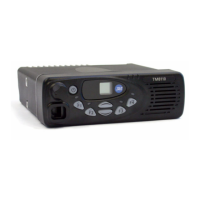58 Description TM8100/TM8200 Service Manual
© Tait Electronics Limited June 2006
The FCL generates an output of 13.012MHz±4kHz. Initially, a VCXO
(voltage controlled crystal oscillator) produces a quasi-regulated frequency in
the required range. The VCXO output is fed to a mixer where it is mixed
with the 13.000MHz TCXO frequency. The mixer, after low-pass filtering
to remove unwanted products, produces a frequency of 12kHz nominally.
This is converted to digital form and transported to the frequency control
block in the custom logic.
The frequency control block compares the mixer output frequency to a
reference generated by the digital clock and creates a DC error signal.
A programmed offset is also added. This error signal is converted to analog
form and used to control the VCXO frequency and reduce the initial error.
Once settled, the loop “locks” to the TCXO frequency with a programmed
offset frequency. The FCL output therefore acquires the TCXO's
frequency stability.
Modulation The full bandwidth modulation signal is obtained from the DSP in digital
form at a sample rate of 48kHz. In traditional dual-point modulation
systems the modulation is applied, in analog form, to both the frequency
reference and the VCO in the RF PLL, combining to produce a flat
modulation response down to DC. Reference modulation is usually applied
directly to the TCXO.
In the system employed in the radio, the frequency reference is generated by
the FCL, which itself requires dual-point modulation injection to allow
modulation down to DC. With another modulation point required in the
RF PLL, this system therefore requires triple-point modulation.
The modulation signals applied to the FCL are in digital form while for the
RF PLL (VCO) the modulation signal is applied in analog form.
The modulation cross-over points occur at approximately 30 and 300Hz as
determined by the closed loop bandwidths of the FCL and RF PLL
respectively.
Frequency
Generation
The RF PLL has a frequency resolution of 25kHz. Higher resolution
cannot be achieved owing to acquisition-time requirements and so for any
given frequency the error could be as high as ±12.5kHz. This error is
corrected by altering the reference frequency to the RF PLL. The FCL
supplies the reference frequency and is able to adjust it up to ±300 ppm with
better than 0.1ppm resolution (equivalent to better than 50Hz resolution at
the RF frequency). The FCL offset will usually be different for receive and
transmit modes.
Fast Frequency
Settling
Both the FCL and RF PLL employ frequency-acquisition speed-up
techniques to achieve fast frequency settling. The frequency-acquisition
process of the FCL and RF PLL is able to occur concurrently with minimal
loop interaction owing to the very large difference in frequency step size
between the loops.

